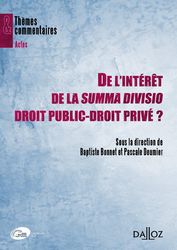
Updated: April 4, 2018 (Initial publication: Nov. 12, 2017)
Publications

Pour lire l'article en français, cliquer sur le drapeau français.
This working paper serves as a support for an article published in French in the Recueil Dalloz.
In Lisbon, in the Web Summit of November 2017, a machine covered with a skin-like material and a sound-producing device gave a speech in public at this conference on digital. For example, a French article tells the event by this title : Le premier robot citoyen donne sa propre conférence au web summit (The first citizen robot gives his own conference to the web summit).
Some time later, reports show the same robot walking and taking more than 60 facial expressions, the text laudatif that accompanies the images designating the automaton by the article: she.
The machine, which falls legally within the category of "things", is thus presented as a person.
Let's look elsewhere.
Women, who are human beings, sign contracts by which they agree to give birth to children, with whom they claim they have no connection, that they are not mothers, that they will hand them over immediately at the exit of their belly to those who desired their coming, this desire for parenthood creating by hitself the true and only link between the child and his "parents of intent". The mother-carrier is often openly referred to as "oven".
The woman, who falls legally within the category of the "person", is thus presented as a thing.
The two sensational phenomena are of the same nature.
They call two questions:
1. Why? The answer is: money. Because both are the result of the new construction of two fabulous markets by supply.
2. How? The answer is: by the destruction of the distinction between the person and things.
The distinction between person and things is not natural, it is legal. It is the base of the western legal systems, their summa divisio.
If this distinction disappears, and for money to flow, it must actually disappear, then the weak human being will become the thing of the strong one.
Read below the developments.
It is true that in 1966, the BBC already presented a sort of robot being the "ideal" servant and designating it by the article "she".
Feb. 25, 2014
Conferences

Le droit est un système qui ne fonctionne bien qu’à base de qualifications, de définitions et de catégories fondamentales. Or, il semble que l’on s’achemine vers une accumulation de dispositions pointilleuses et disparates pour réagir au coup par coup à propos de tels ou tels type de robots. Si l’on reprend une vision plus globale et plus classique, l’on doit constater que les robots à la fois remettent en question la summa divisio entre "personne" et "choses", sur laquelle tout le droit occidental s’est construit, et qu’il paraît difficile de s’en passer. Pragmatiquement, l’on ne doit pas écarter la confrontation du couple infernal "personne/chose" forgée par le droit romain avec le phénomène multiple des robots.
Pour accéder à la problématique détaillée et au plan de l'intervention, voir ci-dessous.
Nov. 26, 2010
Thesaurus : Doctrine

Référence complète : Picod F. , Le droit de l'Union européenne est-il soluble dans la summa divisio droit privé - droit public ? , in Bonnet, B. et Deumier, P., De l'intérêt de la summa divisio droit public - droit privé ?, coll. "Thèmes & Commentaires - Actes", Dalloz, nov. 2010, p 57-63.
Les étudiants de Sciences po peuvent lire l'article en accéder via le drive au dossier MAFR - Régulation
Nov. 26, 2010
Thesaurus : Doctrine

Référence complète, Bergé, J.-S., La summa divisio droit privé - droit public et le droit de l'Union européenne : une question pour qui ? une question pour quoi ?, in Bonnet, B. et Deumier, P. (dir.), De l'intérêt de la summa divisio Droit public - Droit privé ? , coll. "Thèmes & Commentaires - Actes", Dalloz, nov. 2010, p., 45-56.
Les étudiants de Sciences po peuvent lire l'article via le drive de Sciences de po, dossier MAFR - Régulation
Sept. 10, 2010
Thesaurus : Doctrine

Référence complète : Picard, E., Pourquoi certaines branches du droit échappent-elles à la summa divisio ?, in BONNET, Baptiste et DEUMIER, Pascale (dir.), De l’intérêt de la summa divisio droit public-droit privé ?, coll. "Thèmes & Commentaires - Actes, Dalloz, Paris, 2010, pp. 66-95
Résumé
Dans une première partie, Etienne Picard critique la conception ordinaire de la summa divisio entre droit public et droit privé.
En effet, il paraît aujourd'hui naturel d'associer des matières à ce qui serait un corpus, constitué par le droit public d'un côté et le droit privé de l'autre. Cette liste de matières mises d'un côté ou de l'autre serait convenue. Dès lors, nous serions dispensé de rechercher "l'essence" du droit public d'une part et du droit privé d'autre part, pour dans un second temps leur rattacher telle et telle matière.